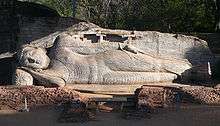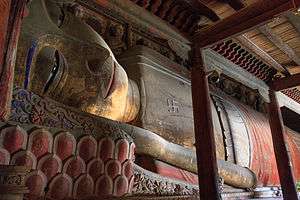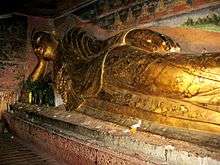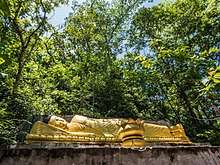Reclining Buddha

A reclining Buddha is a statue that represents Buddha lying down and is a major iconographic and statuary pattern of Buddhism. It represents the historical Buddha during his last illness, about to enter the parinirvana. He is lying on the right flank, his head resting on a cushion or relying on his right elbow, supporting his head with his hand. After the Buddha's death, his followers decide to build a statue of him lying down. They first build the Reclining Buddha statue inside of the Wat Pho Temple then decades later; they start making the sculpture everywhere in South East Asia.
This pattern seems to have emerged at the same time as other representations of the Buddha in the Greco-Buddhist art of Gandhara.
Notable examples



- Winsein Tawya Buddha (Mawlamyaing) - 182.9 metres (600 ft)[2]
- Thanboddhay Pagoda (Monywa) - 101 metres (331 ft)[2]
- Myathalyaung Buddha (Bago) - 82 metres (269 ft)[2]
- Lawka Tharahpu Buddha (Dawei) - 73.6 metres (241 ft)[2]
- Chaukhtatgyi Buddha Temple (Yangon) - 66 metres (217 ft)[2]
- Shwethalyaung Buddha (Bago) - 54.8 metres (180 ft)[2]
- Manuha Temple (Bagan)
- Phowintaung, near Monywa
- West side of the Baphuon in Angkor
- Monolithic Buddha of the Phnom Kulen (lying on his left side)
- Golden gilded Buddha on Sambok Mountain in Kratie Province (to his right side)
- Bhamala Buddha Parinirvana which is 1,800 years old, oldest in the world.[3]
- Cave #26 of Ajanta
- Wat Chayamangkalaram in Penang
- Sam Poh Tong in Perak
- Wat Phothivihan in Tumpat, Kelantan
- Dambulla
- Gal Vihara in Polonnaruwa (12th century)
- Buddha of Ajina-Tepa (13 meters long), on display in the National Museum in Dushanbe
References
- ↑ "Guide to the Wild East of Cambodia – what to do and where to go in the Green Triangle".
- 1 2 3 4 5 6 Ma Thanegi (February 2014). "Chaukhtutgyi Reclining Buddha Image" (PDF). My Magical Myanmar. Archived from the original (PDF) on 4 March 2016. Retrieved 19 July 2015.
- ↑ "http://www.dawn.com/news/1264290". External link in
|title=(help)
External links
![]()